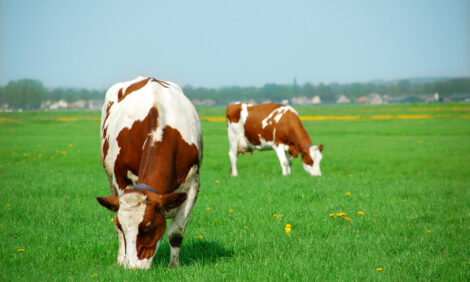



CRC Estimating Breeding Values for Tender Beef
AUSTRALIA - The Queensland beef industry has been introduced to a new tool which aims to further improve the consumer satisfaction of beef.Launched at Brahman week in Rockhampton, trial tenderness marker assisted Estimated Breeding Values (EBVm) should increase the rate of genetic gain in the area of beef tenderness.
Dr Heather Burrow, Beef CRC, CEO said meat tenderness is the most prized attribute among consumers. “Previously, we haven’t had a combined measure of whether an animal will produce tough or tender meat. Trial tenderness EBVm can help produce genetically superior animals for tenderness.”
The trial tenderness EBVm combines pedigree, measured performance and GeneSTAR™ DNA markers to create a new BREEDPLAN EBV.
* "Breeders can use tenderness EBVm to breed genetically superior bulls for tenderness." |
|
Project coordinator Don Nicol
|
The new trial tenderness EBVm is the result of the ‘SmartGene for Beef’ Project, funded by the Queensland Department of Tourism, Regional Development and Industry.
Partners in the project include Animal Genetics and Breeding Unit (AGBU), Beef CRC, Agricultural Business Research Institute (ABRI), Catapult Genetics, Meat & Livestock Australia (MLA) and Breedlink in Australia and Cornell University from the United States of America.
Project coordinator Don Nicol, Breedlink said SmartGene for Beef aims to help producers select more efficiently for economically important traits.
“The project validated the GeneSTAR™ DNA markers for tenderness and showed they had a significant effect on meat tenderness as recorded by objective measures of shear force,” Mr Nicol said.
“Shear force is a measure of how much force it takes for a mechanical blade to cut through a piece of meat. It can be likened to how much force it takes to chew a piece of steak. The lower or more negative the value of shear force, the more tender the meat.”
Dr Burrow credited AGBU for putting the trial tenderness EBVm together. She said the trial tenderness EBVm will be of most benefit in more extensive production systems where bos indicus-derived cattle dominate.
“The harsh environments in northern Australia and high bos indicus content both contribute to the production of less tender beef. Tenderness EBVm will go part of the way to addressing that issue,” said Dr Burrow.
Tenderness EBVm will have benefits right along the production chain according to Dr Burrow.
“Breeders can use tenderness EBVm to breed genetically superior bulls for tenderness. All it involves is testing a DNA sample to see whether it carries the markers for tenderness. Additional measures such as shear force and flight time will also help breed for tenderness,” Dr Burrow said.
Dr Burrow said in the future, DNA markers such as GeneSTAR™ markers for tenderness may also be able to be used directly in Meat Standards Australia (MSA), if a new project in conjunction with Pfizer Animal Genetics and MLA is successful.
“Science carried out by the Beef CRC already underpins MSA. Tenderness EBVm are the latest way we’re making eating quality even better,” Dr Burrow said.
TheCattleSite News Desk


